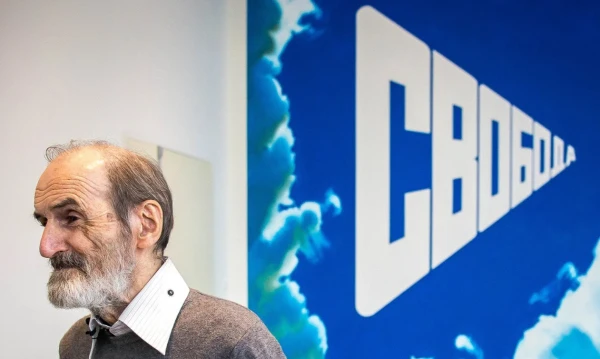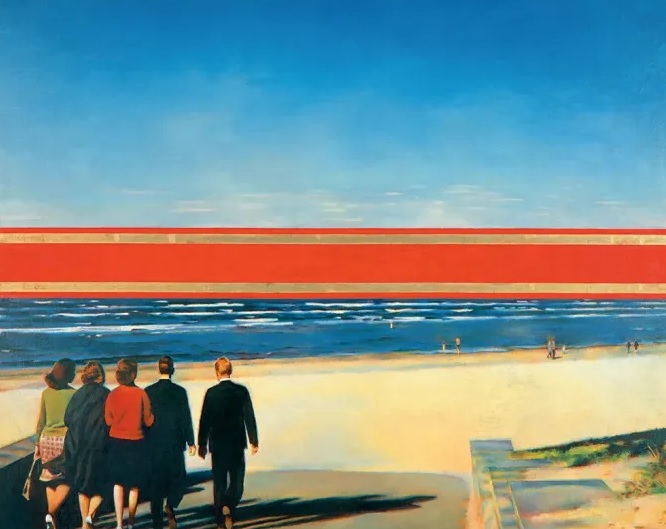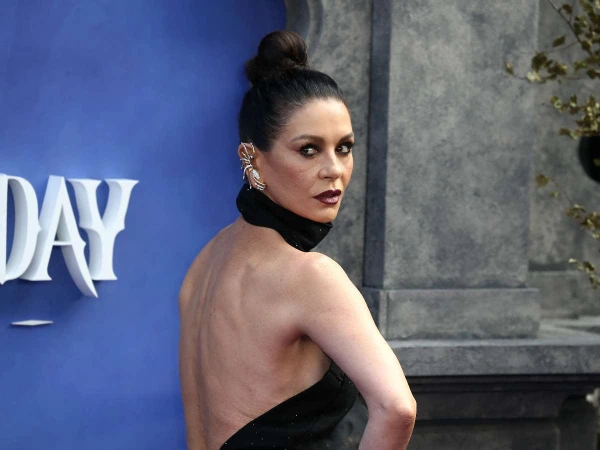
"The best solution turned out to be children's books."
At the age of 92, artist Eric Bulatov passed away in Paris. He is referred to as the founder of social art, Moscow conceptualism, a direct heir of Russian avant-garde, and an artist who managed to create an honest and clear portrait of Soviet civilization. In an interview with Forbes editor Yana Zhilyaeva in 2023, just before his 90th birthday, Eric Bulatov spoke about the current task of contemporary art and why he always felt like a free person.
In the 1970s, a group of Moscow artists — Eric Bulatov, Ilya Kabakov, Viktor Pivovarov, who would later be called "Moscow conceptualists" — worked as illustrators for children's books. To mark Bulatov's 90th birthday, a gallery in Geneva, Skopia, opened an exhibition of book illustrations, showcasing what marked the beginning of the artist's official professional path.
Simultaneously, in Bulatov's unofficial art, in his urban and natural landscapes, in the Soviet slogans on the canvases, the essence and meaning of Soviet civilization are portrayed. References to Russian realists and spatial constructions of avant-gardists are filled with otherworldly light, air, and volume. Bulatov's clouds and skies — the artist's favorite natural backdrop, as seen in the work "Glory to the CPSU" from 1975 — possess the power of ancient gods, moving seas and mountains.
The Tretyakov Gallery, Bulatov's favorite museum, and the Russian Museum are not holding anniversary retrospectives of the artist — they have proven powerless against modern political realities. Today, the majority of Bulatov's works are in foreign private collections, in the Pompidou Center, the Louvre, and MoMA. Only a few pieces are in Russian museum collections. In the Russian Museum, there is one painting (a gift from German collector Peter Ludwig) and several sheets of graphics. Bulatov's paintings in the Tretyakov Gallery are gifts from the artist and the Potanin charitable foundation from 2017.
Eric Bulatov is one of the most expensive contemporary Russian artists. The auction record for his work exceeds £1 million. This is the reason why Bulatov is so sparsely represented in Russian museums. During the Soviet era, museums did not acquire nonconformists for their collections, and after the collapse of the USSR, they could not afford to do so. Here is what he said about himself:
— How did the surname Bulatov work in your biography? For a Russian ear, it sounds very literary, meaningful.
— I have very little information about my family. This was never a topic of conversation. Noble genealogies do not concern me at all. I only know my father, my grandfather, and my grandmother. They were normal petty bourgeois, as it is probably called. My father showed Bolshevik views even in his youth. He was born in 1901, was too young for World War I, but fought on the side of the Reds in the Civil War. At first, he was considered a disgrace to the family. But later everything turned around, and my grandfather, before his death, said that his only mistake in life was that he did not join the Communist Party.
As a person with higher education, a party member, my father worked as a scientific secretary at the Great Soviet Encyclopedia. When the Great Patriotic War began, he immediately volunteered — I was not yet eight years old. And then, in 1944, just before his death, my father came home on leave to Moscow, to our dacha. He was an important figure for me. Before bed, he would always read poetry to me, he knew quite a lot by heart. He loved poetry and read such poems that, it would seem, a communist should not know. For example, "The Dying Swan" by Balmont. I remembered this "Swan" for my entire life. I generally have a good memory for poetry, although my memory is terrible: I forget names, dates. But I remember poetry well.
I started drawing very early and did it with great enthusiasm. At the age of six or seven, I tried to illustrate "Ruslan and Lyudmila." My drawings made a strong impression on my father, and he decided that I should be an artist. This desire of his became a kind of legacy for my mother. Therefore, the question of choosing a profession did not arise for me. Usually, parents object and doubt when their children declare that they will be artists; my mother also had doubts but did not object. This is how she preserved the memory of my father.
— And Bulatov — is it not a revolutionary pseudonym? Is it your real surname?
— No, it is not a pseudonym. My father was named Vladimir Borisovich Bulatov. The family is from Saratov. I know almost nothing about my roots. For some reason, it was never mentioned who our ancestors were, what kind of family we had. But I never showed any interest either.
— Do you think your love for the avant-garde was instilled in you from childhood, stemming from your father? From avant-garde poetry?
— I don’t think so. My father loved Mayakovsky very much, that’s all. I didn’t really know the avant-garde. I first saw the "Black Square" as an adult at the "Paris-Moscow" exhibition at the Pushkin Museum. Although by that time I had already been strongly influenced by Malevich: I hadn’t seen the "Black Square," but I knew a lot about the painting. Because the teachers — I first studied at an art school, the MSU School of Arts, and then at the institute itself — ironically said that this is what the avant-gardists had come to, one just painted a black square. It seemed impossible for us students to believe: how could it be, he just painted a square black? Yes, he just painted it black — and that’s it.
It was supposed to be something to laugh at. But I somehow immediately thought that this was done for a reason, that there was some content in it. And I thought about it for a long time. So this agitation had the opposite effect. Those teachers who considered official Soviet painting the standard of art opposed Malevich. And I did not like Soviet art. I didn’t like it at all. I thought art was something completely different, although I certainly didn’t know much.
What I did know was largely thanks to real artists I met. These were Robert Rafailovich Falk and Vladimir Andreyevich Favorovsky. They explained a lot to me. Then, after Stalin's death, a flood of art that had previously been banned poured in. The exhibition of the French book publisher Skira with albums and monographs of modern French abstract artists. The American exhibition in Sokolniki in 1959, where Jackson Pollock was shown. It was very difficult to figure everything out. It was a stroke of luck when there were people like Falk and Favorovsky who understood and knew this. For me, it was an incredible fortune.
I learned about our avant-gardists later than about Western contemporary art. First, exhibitions of Western art appeared, and only then did they show our avant-garde. By that time, my mind was already prepared, and therefore everything was perceived easily.
— Today, art historians see a dialogue with avant-gardists, with Malevich, in your works.
— Formally, I never set such a task for myself. This is my inner dialogue. Because I thought for years about the "Black Square." It has remained some kind of absolute for me.
For the first time, it struck me with its ambiguity: it is such a work about which nothing definite can be said. We cannot even understand what this black is. Is it a black hole in a white background, or is it a black object lying on a white background? It is both an object and a space at the same time. An incredible work by Malevich.
— Did you already have such a concept of building space when you saw the "Black Square"? Had you already invented it by that time?
— Of course not. I never invent anything. In art, you cannot invent. You can only do. You must see and express clearly. That is the process of art.
Malevich himself could not even explain what he did. He had completely opposite statements. There are cases when a painting is smarter than the artist. Some revelation comes, and then, good luck explaining it.
Of all the interpretations of this painting, of all the explanations by the artist, I like this comment by Malevich: he was walking down the street, thinking about modernism, abstractionism — such a word didn’t even exist yet, but it doesn’t matter. And suddenly someone pushed him sharply in the back. The push knocked him off his thoughts. He irritably turned around and saw that it was a schoolboy with a black backpack on his back. He was probably late, running, pushing people aside. The black square backpack struck Malevich's eyes.
I understand his irritation. Art can arise as inspiration, and it does not necessarily have to come from something bright, shining; it can, on the contrary, come from irritation, even from anger, from something very strong.
I had a similar story with the painting "Horizon." Oleg Vasilyev and I were at the House of Creativity in Crimea, working together on books. February, terrible cold, winds, storms. I caught a chill in my back. It was terribly painful, and I had to go for warming treatments at the clinic.
I was lying on my stomach in front of the window, and outside was the sea. Everything would have been wonderful, but for some reason, the view was blocked by a red stick. It covered the window right where my horizon should have been. It blocked my view of the sea. This stick irritated me terribly. And suddenly I realized, it hit me in the head: fool, you are lucky, they are literally showing you your own life, where what you love is blocked. In general, there was a strong negative impulse. But this does not mean that the painting should evoke negative or positive emotions. It can be anything.

— All your works are about freedom. Air, space, light. When did you feel free yourself?
— I think always. I immediately set myself the goal of being free. Free, for example, from the art that I was taught. From state orders, from all this coercive stuff. But since there could be no other orders besides state ones, I could not exhibit or sell my paintings. So I placed myself in a completely independent position. It remained to understand how to live, what to live on.
Therefore, I decided that I needed to find another profession that would allow me to do my own thing in my free time. The best solution turned out to be children's books. Illustrations for them are really necessary; it is not necessary to illustrate adult books at all. Moreover, in book graphics, the cultural tradition was preserved, and it was possible to find an opportunity to do something decent and not feel like a complete fraud. Oleg Vasilyev and I worked together on books, helping each other. And when there was free time, we would go to our studios, and each would do his own thing.
For me, freedom was the initial goal. It remains so. And then, when we went to the West after exhibitions in Switzerland, in France, I was already a well-known artist, I didn’t need to conquer anything. I was invited, I could choose the gallery and work with it. And I could remain myself. So I was always free, wherever I was.













